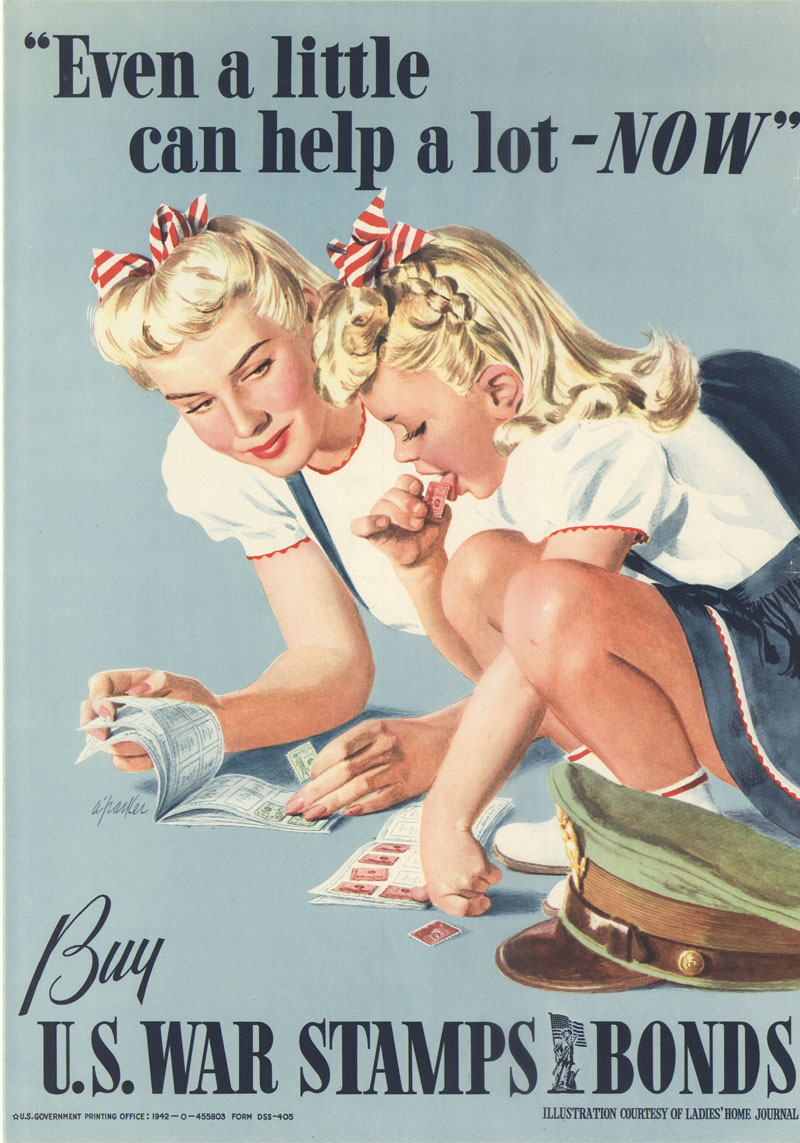WWII 75: Marching to Victory | July 5, 2020

WWII highlights from the Truman Library’s archives and collections
Marching to Victory: How Children Helped Win the War
July 5, 1945
World War II was a total war. Those who were not soldiers were mobilized to some degree. They conserved, raised money, boosted soldiers’ morale, worked in war manufacturing, and contributed to the war effort in countless other ways. Even young people participated in the war effort.
On July 5, 1945, President Harry Truman received a unique report on a campaign waged by a devoted band of home-front workers: thirty million schoolchildren. Florence Shuman and Mead Gruver, who the Treasury Department’s War Finance Division had chosen to represent all of America’s schoolchildren in the White House ceremony, presented President Truman with a humble testimony to the extraordinary efforts of youngsters. The plaque Florence and Mead gave to the president included gold-painted lettering on wood (itself an indication of metal-saving initiatives) that read:
TO PRESIDENT HARRY S. TRUMAN
COMMANDER IN CHIEF OF OUR ARMED FORCES
AMERICA’S SCHOOL CHILDREN ARE PROUD TO PRESENT
WAR EQUIPMENT TO THE VALUE OF $715,000,000
THROUGH THE PURCHASE OF WAR BONDS
DURING THE SCHOOL YEAR ENDING JUNE 1945
How did the government get so many school-aged children involved in the war effort?
The standard government war bond was $25, but a special program enabled children to support the national fundraising drive. Schools across the country held campaigns to raise money, encouraging students to bring in their change and support the purchase of as many war bonds as possible. A child could buy a War Stamp for 25 cents and add it to his or her War Bond booklet. For kids already well-versed in collecting cereal box tops to acquire comic books, Green Lantern magic rings, and other treasures, war stamps and bond booklets were a familiar and exciting opportunity to help out in the war effort.
While an impressive accomplishment, the $715 million raised by the schoolchildren was a drop in the bucket for a war effort that eventually cost the U. S. government $296 billion in military spending alone. Yet, the school war bonds campaign exemplified the patriotism and hard work of ordinary citizens during the difficult war years, and it was this dedication to the cause that set America on the march to victory in 1945. Florence, Mead, and their fellow students had earned the appreciation of President Truman and the government.
75 years ago, World War II ended under President Truman’s decisive leadership. Now, follow key events from the war’s final months with the Truman Library Institute’s series, “Marching to Victory: WWII Highlights from the Truman Library’s Archives and Collections.” The 25-part blog series opens the vaults at Truman’s presidential library to share eyewitness accounts and historic artifacts related to major conflicts and monumental victories – from the Battle of the Bulge to the liberation of Dachau to the unconditional surrender of Japan.
More Marching to Victory
Marching to Victory: The Bombing of Dresden
Marching to Victory: The Yalta Conference
Marching to Victory: The Battle of the Bulge
Marching to Victory: The Tokyo Fire Raids
Marching to Victory: The Battle of Okinawa
Marching to Victory: The Liberation of Buchenwald
Marching to Victory: “The President is Dead”
Marching to Victory: The Liberation of Dachau
Marching to Victory: The Death of Adolf Hitler
Marching to Victory: Germany Surrenders!
Marching to Victory: Victory Gardens
Marching to Victory: Civil Rights
Marching to Victory: The United Nations
Contributed by Will Hickox, Ph.D. He has written for The New York Times and contributed to several digital history projects.
Join our email list to receive Truman updates right in your inbox:



